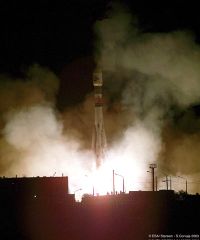Soyuz-Fregat rocket
Overview
The Soyuz-Fregat launch vehicle is part of the overall Soyuz family, based on the original R-7 used to launch Sputnik-1 the world's first artificial launch vehicle. It therefore has the longest flight heritage of any orbital launch vehicle.
Soyuz-Fregat is designed for cost-effective solutions on missions that require medium and high altitude Earth orbits. Soyuz-Fregat uses the basic Soyuz vehicle (often associated with delivering supplies to the International Space Station) that composes of a lower/first stage (with 4 booster rockets), a central/second stage and an upper portion containing the third stage (the Fregat upper stage) and payload. The Mars Express mission used such a rocket to be inserted into Earth orbit before its journey to Mars.
The Fregat is an upper stage which can be placed on the top of a Soyuz core vehicle to create the Soyuz-Fregat configuration. Fregat was originally used for interplanetary missions which were launched on Proton vehicles.
According to the Starsem launch log there have been twelve flights of the Soyuz-Fregat configuration as of April 2007.
The Soyuz-Fregat is well-known for its reliability and high technical standards.
The Soyuz-Fregat launcher version has a 5,000kg payload performance to a 450km circular orbit inclined 51.8 deg, or 4,000 kg to a 1,400 km circular orbit.







